The Coelacanth
Everyone thought that coelacanths had died out with the dinosaurs. But then a strange fish appeared in a trawler’s net, and a scientist from Knysna identified it...
Saturday, 22 December, 2018, marked the 80th anniversary of the day on which Marjorie Courtenay-Latimer spotted the coelacanth on the deck of Capt. Goosen's fishing trawler.
It was a significant moment in science for South Africa and the world, and we salute her!
The coelacanth display in the Knysna Museum’s Angling Museum (in the Old Gaol), traces through photos, a life-size model of a coelacanth, and various artefacts the story of how the fish was introduced to science; of how the first specimen turned up in a trawlers’ net; of how the ichthyologist JLB Smith identified it from a crude drawing sent to him at his holiday house here in Knysna; of the hunt for a second specimen (a hunt that began before World War II, and ended only years after it); and of what we know about the species’ distribution and habits today.
It’s a rollicking adventure, and worth telling in full - which is why the article that follows is quite a long read (say, 10 minutes).
So have a seat, order yourself a treat, and take yourself back to a time more than 65 million years ago ...
Fossil coelacanths
The French scientist Louis Agassiz described a group of fossil coelacanths in his 1839 book, Poissons Fossiles (The Fossil Fish).
He chose the name because of the characteristic, hollow spines that project from the caudal fin (backbone). Derived from the Greek ‘coel’ (space) and ‘acanthus’ (spine), the word ‘coelacanth’ thus means ‘hollow space.’
The ancient coelacanths included a number of different species of different sizes - ranging from only a few centimetres to about 30 centimetres in length - all of which shared the general shape and proportions of the modern coelacanth.
Coelacanths belong to a class of vertebrates known as the Sarcopterygii, and are therefore closely related to another surviving primitive group: the lungfish. (Unlike the coelacanth, though, lungfish have the ability to breathe air when removed from the water).
Given the fact that the fossil coelacanths all had limb-like appendages which seem quite muscular, some early palaeontologists believed that they may have been a ‘missing link’ between marine and terrestrial animals. (This idea arose after the publication of Charles Darwin’s ‘On the Origin of Species’ in 1859).
The problem with this scenario, though, was that there was no real evidence that coelacanths spent any of their lives out of the water - or that they’d survived the end of the the Cretaceous Period, when the dinosaurs went extinct - about 65 million years ago.
But then in 1938 the world learned that they had survived.
And that they were definitely not amphibian...
A scaly surprise
Retrieving his net in December 1938 during a cold water upwelling off the mouth of the Chalumna River, west of East London - a situation which often revealed unusual specimens that he would generally keep for the curator of the East London Museum, Marjorie Courtney-Latimer - Captain Hendrik Goosen of the Irvin & Johnson fishing vessel, Nerine, spotted a huge, bright blue fish of a type he’d never seen before.
It was still alive - but at 150 cm long, and with a weight of 57.5 kg, it was far too big to fit into his on-board aquarium.
There was nothing else to do: he left it on the deck, where it survived for only a few hours.
As soon as he docked in East London, the Captain sent for Ms. Courtney-Latimer, who realised immediately that he’d found something important.
She made a sketch of the fish, and sent the drawing by mail to Professor JLB Smith at his holiday home in Knysna, asking for a possible identification.
The letter reached Prof. Smith on the 3rd of January, 1939. It seems he knew instantly exactly what it was - but he also knew that he’d need the soft parts in order to write a proper, scientific description of it.
He telegraphed Ms. Courtney-Latimer to save them, but it was too late - she’d removed them and thrown them away when the specimen had begun to putrefy.
Without even seeing it, though, he knew that it must be one of the crossopterygians (Sarcopterygii), and that it was most likely a coelacanth.
This was a remarkable connection to make: Agassiz had described them as smallish fishes from shallow, fresh water areas of the northern hemisphere: but this one was a massive 150 centimetres long, and it had lived in the deep, salt water of a southern ocean.
Frustrated by heavy rains and other delays, Prof. Smith was only finally saw the fish for the first time six weeks after it had been caught.
He named it Latimeria chalumnae - after Marjorie Courtney-Latimer and the Chalumna River - and the world couldn’t get enough of it.
A photograph of JLB Smith and the fish was reprinted in newspapers around the globe, and a one-day viewing of the specimen at the East London Museum is said to have attracted a crowd of 20,000 people.
The vital second specimen
Prof. Smith now became obsessed with finding a second specimen - firstly because the loss of the soft inner parts of the first one meant he couldn’t write a complete zoological description, and secondly because he wanted to know where they really lived.
He theorised that the East London fish might have been a stray, possibly forced out of its range by the cold water, and that it might more likely have come from warmer waters further to the north.
He searched and traveled widely along the East coast of Africa, looking for another specimen all the while.
Although he was forced to give this up during the War, he remained committed to the task, and continued after hostilities ended in 1945.
In 1948 he distributed leaflets in the search area, offering a reward of £100 for the capture of a second coelacanth.
A Captain Eric Hunt distributed some of these fliers in the Comores, and sure enough, on the 20th of December, 1952, a fisherman named Ahmed Houssein caught a coelacanth using a hand line at a point about 200 metres off the island of Anjouan.
Mr. Houssein brought his fish to Capt. Hunt and asked him to help him collect his reward.
Capt. Hunt knew from earlier discussions with Prof. Smith and his wife, Margaret (also an ichthyologist) that it was imperative that he preserve the fish and its soft parts. He did what he could as soon as he could, and then sent a telegram to Prof. Smith at his office at the University of Grahamstown. But the Professor wasn’t there - he’d been on a fish-collecting safari on the East coast, and he was currently sailing home aboard the Dunnottar Castle.
The telegram was forwarded to Durban, and the news caught up with the Professor when he landed on the 24th of December.
There were no scheduled flights between South Africa and the Comores in those days, and Prof. Smith couldn't find a charter plane - so on Christmas Day, desperate not to lose the opportunity, he phoned the Prime Minister of South Africa, DF Malan, and convinced him to send a military Dakota to fly him to collect the fish and bring it to his lab for dissection.
Surprisingly, perhaps, the Prime Minister agreed.
In her book, ‘A Fish Caught in Time’ (Fourth Estate, London, 1999), Samantha Weinberg describes how the South African Air Force had to get permission from the Mozambican authorities - both to mount a military flight across their air space, and to refuel in Lourenço Marques.
Weinberg writes that one of the officers in Durban called a government official in Lourenço Marques at 2:00 a.m. on the day of the flight: ‘
“Roger,” said the Lourenço Marques man. “And what is the mission of this flight?”
‘Durban” “To get a fish.”
‘L.M.: “Have I heard you right? A F.I.S.H.?
‘Durban: “Yes, a fish.”
‘L.M.: “You mean a thing with scales?”
‘Durban: “Roger.”
‘L.M.: “Do you really think our Government is going to believe that? You must think our guys are stupid – can’t you think of a better story for why you want to cross our territory in a military plane?”’
But the Government did give its permission, and Professor Smith landed on Anjouan on the 28th of December, 1952.
The second specimen seemed different to the first - it didn’t have two dorsal fins, as did Latimeria - so Prof. Smith named it Malania anjounae (after Prime Minister Malan and the Island where it had appeared), but closer investigation would later reveal that this was incorrect, and that it was, in fact, Latimeria chalumnae. It had simply lost its front fins - possibly due to injury when it was still quite young.
After leaving the Comores, the Dakota headed for Cape Town so that the Professor could show his prize to the Prime Minister.
Flying low over Knysna en route, they ‘bombed’ the Smith’s house with a letter addressed to Bob, the Professor's son from his first marriage, describing the experiences of the past few days.
Prime Minister Malan examined the fish, the media reported it around the world, and Prof. Smith returned to Grahamstown to spend the next few months working on dissecting it and fully describing it for science.
"On their return to Durban with the fish on Monday. 29th December 1952, Smith gave an epic radio interview at 22h00 on the tarmac at Durban Airport with George Moore of the SABC, wherein he recounted the dramatic moments when he first saw the fish" (Mike Bruton - The Fishy Smiths. Penguin, Century City, 2018)
- Listen to JLB Smith's interview in this video:
The next 150 specimens
Now that everyone knew where they lived, the race was on!
Although the government of the Comores allowed only French scientists to search for them, more than 150 coelacanths were caught off the Islands over the following 15 years.
But this restriction was lifted when the country gained independence, and Professor Hans Fricke of Germany’s Max Planck Institute mounted diving expeditions - using a self-built submarine - to film the Coelacanth in its natural habitat in both 1986 and again 1987.
Success came on the 41st dive of the second expedition. Sadly for Prof. Ficke, though, he wasn’t aboard when his colleague, Jürgen Schauer, took the vessel down and finally managed to film the coelacanth: he’d just left left the islands to return to Germany.
The expedition found that coelacanths feed at night, and prefer to hide in caves during the day.
Coelacanths around the world
Coelacanths have since been discovered off Mozambique, Madagascar, Indonesia, and, in November 2000, off the coast of South Africa. And, like those first and second specimens, all have a story to tell.
Although the first Mozambican coelacanth was caught in 1972, it was the second - caught in 1991 - that significantly added to our knowledge of the species.
Important coelacanths have an uncanny habit of turning up around Christmas time. This 1.79-metre, 98 kg specimen was caught by a Japanese fishing trawler, and handed over to Dr. Augusto Cabral of the Museum of Natural History in Maputo. True to form, the JLB Smith Institute of Ichthyology (as it was known then - it’s now the South African Institute for Aquatic Biodiversity) received a fax announcing the fish’s arrival on Christmas Eve.
And, also in true coelacanth style, the director of the Institute, Professor Mike Bruton and Prof. Fricke immediately arranged to fly to Mozambique visit the fish.
Weinberg writes that, “Cabral assured them that it was definitely a coelacanth – only the second to have been trawled and, indeed, to have been found anywhere but the Comores. The bad news was that – in another uncanny mirror to the events of 1938 – lacking the facilities to keep it frozen, Dr. Cabral had been forced to dissect the fish and discard its internal organs. The good news, however, was that he had found twenty-six perfectly preserved coelacanth pups inside, which he had managed to preserve.
“The Mozambique fish threw a slew of series and assumptions into the air. Not only did the place and method of its capture revive former conjectures that the coelacanth inhabited a much wider area – and that the East London specimen was not necessarily a stray – but it also threw oil into the simmering debate about the coelacanth’s reproductive processes.
“Until that point, all estimates of coelacanth population dynamics had been based on the American Museum’s specimen (caught in 1962 in the Comores and known as Specimen Twenty Six), with its five embryos. Then along came the Mozambican fish, quintupling the potential birth rate; if coelacanths could produce up to twenty six young, then perhaps they weren’t as endangered as we thought? It also destroyed, once and for all, Eugene Balon’s theory of inter-uterine cannibalism. Specimen Twenty-Six was dissected in 1975, and was found to contain five pups that were still attached to their yolk-sacs. However, as coelacanths were known to produce up to 200 eggs, Balon, of Guelph University in Canada, proposed the theory that they displayed the same habit of oophagy (inter-uterine cannibalism) as do the sharks. If this was the case, it would have seriously limited the coelacanth’s reproductive capacity.
“To the sceptics and pessimists of the coelacanth world, the Mozambique specimen wasn’t such a big deal. Any live bearer – even one that produces twenty-six offspring – is a slow producer, and it was entirely possible, they argued, that, like the East London Fish, this coelacanth had also got caught in the southerly current and drifted from the Comoros to the waters off Pebane where it was caught.”
But the sceptics were wrong. In August 1993, a 32 kg specimen was caught in a shark net off the village of Anakaó on the south-west coast of Madagascar – 1,300 km south of Grand Comore. And another one was caught in the same place, and under similar circumstances, in 1997.
This co-incidence was too great, and it was now commonly accepted that coelacanths occurred over a greater geographical area than everyone had originally believed.
On the 18th of September of that same year – 1997 – Dr. Mark Erdmann, an American marine biologist based in Indonesia, saw a coelacanth on the cart of an old fisherman at the fish market in Bali.
The old man was unable to give him accurate details about where he’d caught it, and he was obviously uncomfortable with all the attention. Reluctantly, Dr. Erdmann asked no further questions - although he would subsequently regret not having bought the specimen himself.
Like Professor Smith before him, Dr. Erdmann decided to offer a reward for the capture of a second specimen - and soon enough, one was caught off the island of Manado Tua by a man named Om Lameh. It was still alive when he brought it to Dr. Erdmann, who placed it in the waters of the bay in front of his house to film it as it swam. Eventually though, Dr. Erdmann decided to kill and dissect the fish.
It wasn’t an easy decision, but live coelacanths never survive for more than a few hours after the ascent from the great depths at which they live. (This, of course, is why it’s impossible to keep coelacanths in aquariums. And anyway, even if it were possible, conservationists believe that the hunt for live specimens would threaten the species’ survival.)
Finally: a South African colony of coelacanths
On 27 November 2000, whilst diving to a depth of 104 metres, a group of divers found and photographed a shoal of coelacanths off Sodwana Bay, in South Africa’s Greater St Lucia Wetland Park (northern KwaZulu-Natal).
Dr. Phil Heemstra, of the JLB Smith Institute of Ichthyology, positively identified the specimens in the photographs - and the discovery finally confirmed that the coelacanth was as South African a fish as any other after all.
Importantly for its continued survival, however, the South African colony lives in a protected area: the Greater St Lucia Wetland Park was declared a World Heritage Site in December 1999.
The South Africa’s Minister of Environment Affairs and Tourism, Valli Moosa, reacted to the find by quickly publishing emergency regulations that further protected the coelacanth - which may now not be disturbed or caught. In addition, it’s illegal to attempt to locate and/or film them in South African waters without a permit issued by the Minister.
A little about the natural history of the Coelacanth
Coelacanths feed mainly on fish, eels, skates, shark, squid and octopus.
There are no obvious difference in appearance between males and females, except perhaps that the female is slightly more robust.
The young develop inside the mother and remain there until they’re large enough to fend for themselves. One female that was caught was carrying 26 pups that were about to be born. They were between 308 and 358 mm long, and weighed between 410 and 502g.
Coelacanths live at depths of between 100 and 700 metres. Their habit of hiding in caves during the day may be a defense against their main predators - sharks.
They’re sociable, and often congregate in their caves, possibly returning to the same home cave day after day.
They show no evidence of any aggressive behaviour.
Coelacanth conservation
In 1987 Prof. Bruton and three other ichthyologists founded the Coelacanth Conservation Council, with headquarters in the Comoran capital of Moroni.
The South African Institute for Aquatic Biodiversity now manages the African Coelacanth Ecosystem Programme (ACEP), "a research platform which provides access to research infrastructure (e.g. ship time, coastal craft, remote operated vehicles, etc.) and associated funding to the research community to undertake research along the east coast of South Africa. ACEP is a flagship programme of the Department of Science and Technology (DST) and the National Research Foundation (NRF), and its key partners are the Department of Environmental Affairs (DEA – Oceans and Coasts), Department of Agriculture Forestry and Fisheries (DAFF) and the South African Environmental Observation Network (SAEON). ACEP is managed by the South African Institute for Aquatic Biodiversity (SAIAB) which is a National Facility of the NRF." (AECP)
Trade in coelacanths is now banned since they are listed in Appendix 1 of the Convention on International Trade in Endangered Species (CITES)
- Short link for sharing this page: bit.ly/KnyCoel
Article by Martin Hatchuel for Knysna Museum

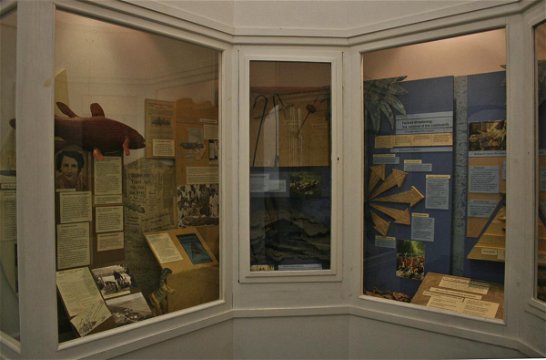
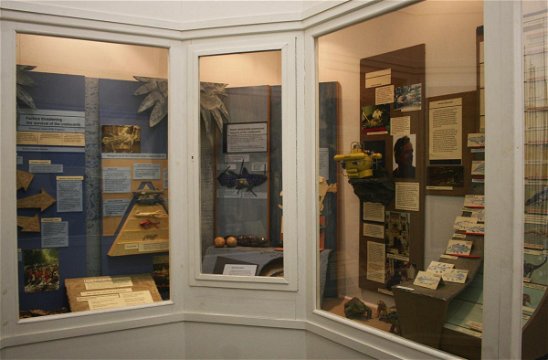
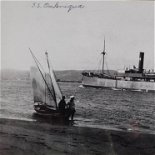
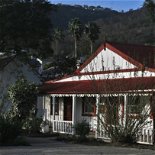



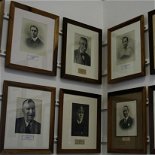

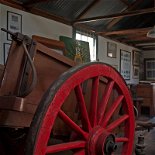
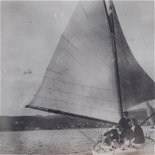

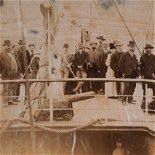
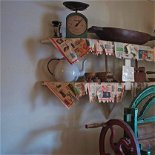

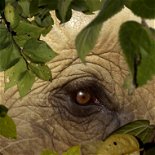
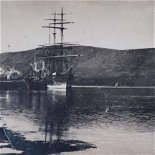


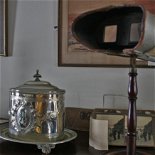
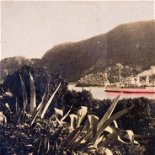
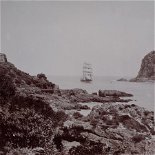

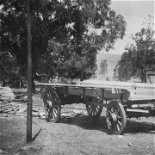
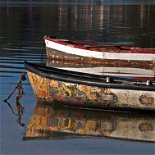
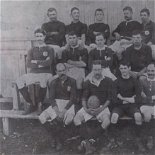
Share This Page